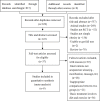Acupuncture versus sham acupuncture for simple obesity: a systematic review and meta-analysis
- PMID: 32015189
- PMCID: PMC7146934
- DOI: 10.1136/postgradmedj-2019-137221
Acupuncture versus sham acupuncture for simple obesity: a systematic review and meta-analysis
Abstract
Obesity is a growing chronic health problem worldwide. Studies about acupuncture for obesity treatment are many. But there are some doubts about the effectiveness of acupuncture versus sham acupuncture in treating obesity due to its lack of medical evidence. Therefore, the aim of this study is to assess the efficacy of acupuncture for obesity treatment and provide clinic evidence. Four English databases (PubMed, EMBASE, Web of Science and Cochrane Central Register of Controlled Trials) and four Chinese databases (China National Knowledge Infrastructure, Chinese BioMedical Database, Chinese Scientific Journal Database and Wan-Fang Data) were searched from their receptions to August 2019. Randomized controlled trials (RCTs) using the comparison between acupuncture and sham acupuncture to treat simple obesity were included. The primary outcome of body mass index (BMI) would be used to measure the effect of acupuncture on obesity. According to the trial data extraction form based on the Cochrane Handbook, two reviewers separately extracted the data. Risk of bias of the RCTs was assessed by the Cochrane Risk of Bias Tool. The study included 8 RCTs with 403 patients. When compared with sham acupuncture, acupuncture showed obviously effect in BMI reduction (MD=1.0kg/m2, 95% CI=0.6 to 1.4, P<0.001). There was also significant reduction in body weight (MD=1.85kg, 95%CI=0.82 to 2.88, p<0.001), WC (MD=0.97cm, 95%CI=0.24 to 1.71, p=0.01) and body fat mass percentage (MD=1.01, 95%CI=0.25 to 1.77, p<0.05). However, WHR (MD=0.01, 95%CI=0 to 0.03, p>0.05) was not statistically and significantly different between the acupuncture and control groups. Adverse effects were reported in 3 studies. The review suggests that acupuncture is an effective therapy for simple obesity rather than a placebo effect. This potential benefit needs to be further evaluated by longer-term and more rigorous RCTs.
Keywords: complementary medicine; information management; public health.
© Author(s) (or their employer(s)) 2020. Re-use permitted under CC BY-NC. No commercial re-use. See rights and permissions. Published by BMJ.
Conflict of interest statement
Competing interests: None declared.
Figures








Comment in
-
Regarding a recently published meta-analysis on acupuncture for obesity.Postgrad Med J. 2020 Nov;96(1141):722. doi: 10.1136/postgradmedj-2020-137647. Epub 2020 Mar 20. Postgrad Med J. 2020. PMID: 32198233 No abstract available.
Similar articles
-
Acupuncture vs sham acupuncture for simple obesity: A protocol for systematic review and meta-analysis.Medicine (Baltimore). 2019 Oct;98(42):e17562. doi: 10.1097/MD.0000000000017562. Medicine (Baltimore). 2019. PMID: 31626121 Free PMC article.
-
The impact of acupuncture combined with acupoint catgut embedding on simple obesity: A systematic review and meta-analysis.Medicine (Baltimore). 2023 Jul 14;102(28):e34234. doi: 10.1097/MD.0000000000034234. Medicine (Baltimore). 2023. PMID: 37443503 Free PMC article.
-
Acupoint catgut embedding for obesity: A protocol of systematic review.Medicine (Baltimore). 2020 Dec 18;99(51):e23728. doi: 10.1097/MD.0000000000023728. Medicine (Baltimore). 2020. PMID: 33371124 Free PMC article.
-
Systematic review and Meta-analysis of acupuncture and acupoint catgut embedding for the treatment of abdominal obesity.J Tradit Chin Med. 2022 Dec;42(6):848-857. doi: 10.19852/j.cnki.jtcm.2022.06.002. J Tradit Chin Med. 2022. PMID: 36378041 Free PMC article.
-
Clinical Evidence for Association of Acupuncture and Acupressure With Improved Cancer Pain: A Systematic Review and Meta-Analysis.JAMA Oncol. 2020 Feb 1;6(2):271-278. doi: 10.1001/jamaoncol.2019.5233. JAMA Oncol. 2020. PMID: 31855257 Free PMC article.
Cited by
-
Acupuncture improved lipid metabolism by regulating intestinal absorption in mice.World J Gastroenterol. 2020 Sep 14;26(34):5118-5129. doi: 10.3748/wjg.v26.i34.5118. World J Gastroenterol. 2020. PMID: 32982113 Free PMC article.
-
Acupuncture-assisted lifestyle intervention improve the metabolic status and spontaneous brain activity of type 2 diabetes Mellitus patients: a randomized, clinical trial.Diabetol Metab Syndr. 2024 Oct 28;16(1):255. doi: 10.1186/s13098-024-01489-4. Diabetol Metab Syndr. 2024. PMID: 39468590 Free PMC article.
-
Acupuncture against the metabolic risk factors for stroke: A systematic review of systematic reviews.Medicine (Baltimore). 2022 Sep 2;101(35):e30086. doi: 10.1097/MD.0000000000030086. Medicine (Baltimore). 2022. PMID: 36107536 Free PMC article.
-
Mechanism of Action of Acupuncture in Obesity: A Perspective From the Hypothalamus.Front Endocrinol (Lausanne). 2021 Apr 2;12:632324. doi: 10.3389/fendo.2021.632324. eCollection 2021. Front Endocrinol (Lausanne). 2021. PMID: 33868169 Free PMC article. Review.
-
Dilemmas in Elderly Diabetes and Clinical Practice Involving Traditional Chinese Medicine.Pharmaceuticals (Basel). 2024 Jul 16;17(7):953. doi: 10.3390/ph17070953. Pharmaceuticals (Basel). 2024. PMID: 39065801 Free PMC article. Review.
References
-
- World Health Organization Obesity and overweight, 2015. Available: http://www.who.int/mediacentre/factsheets/fs311/en// [Accessed 22 Jan 2017].

